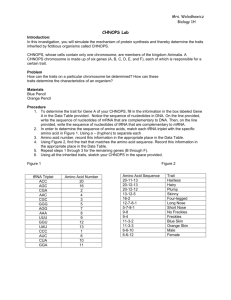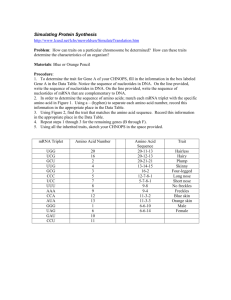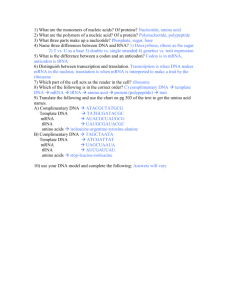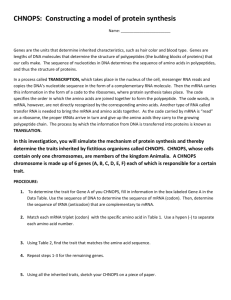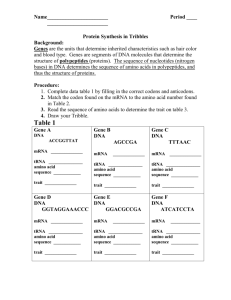Simulating Protein Synthesis to create a CHNOPS! Read the
advertisement
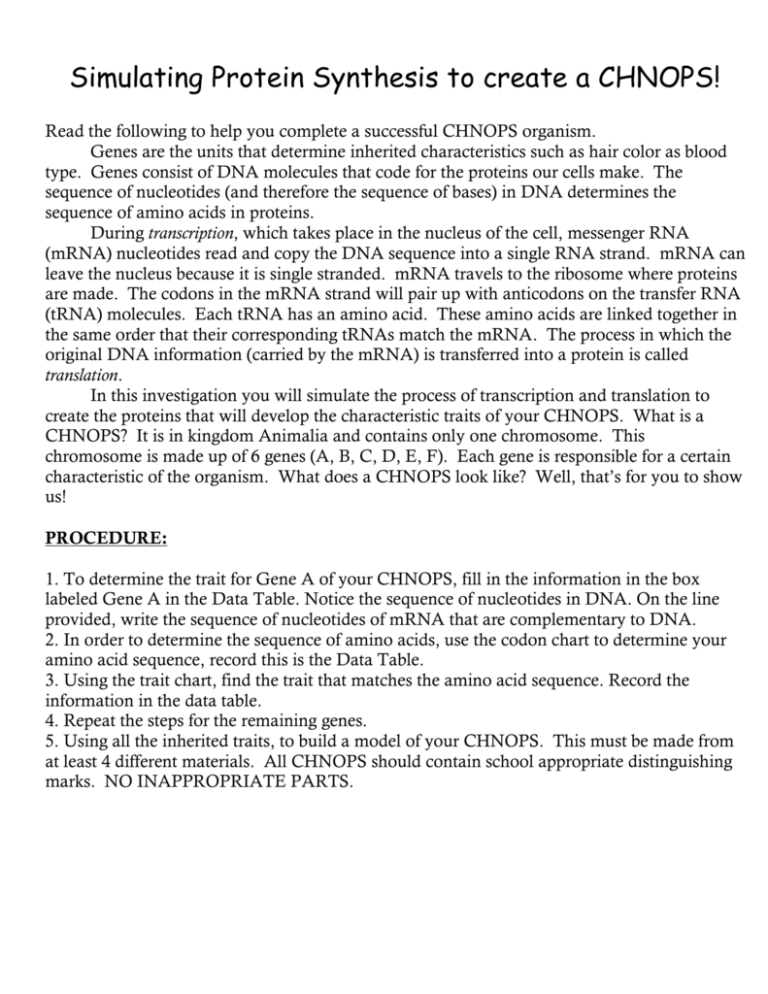
Simulating Protein Synthesis to create a CHNOPS! Read the following to help you complete a successful CHNOPS organism. Genes are the units that determine inherited characteristics such as hair color as blood type. Genes consist of DNA molecules that code for the proteins our cells make. The sequence of nucleotides (and therefore the sequence of bases) in DNA determines the sequence of amino acids in proteins. During transcription, which takes place in the nucleus of the cell, messenger RNA (mRNA) nucleotides read and copy the DNA sequence into a single RNA strand. mRNA can leave the nucleus because it is single stranded. mRNA travels to the ribosome where proteins are made. The codons in the mRNA strand will pair up with anticodons on the transfer RNA (tRNA) molecules. Each tRNA has an amino acid. These amino acids are linked together in the same order that their corresponding tRNAs match the mRNA. The process in which the original DNA information (carried by the mRNA) is transferred into a protein is called translation. In this investigation you will simulate the process of transcription and translation to create the proteins that will develop the characteristic traits of your CHNOPS. What is a CHNOPS? It is in kingdom Animalia and contains only one chromosome. This chromosome is made up of 6 genes (A, B, C, D, E, F). Each gene is responsible for a certain characteristic of the organism. What does a CHNOPS look like? Well, that’s for you to show us! PROCEDURE: 1. To determine the trait for Gene A of your CHNOPS, fill in the information in the box labeled Gene A in the Data Table. Notice the sequence of nucleotides in DNA. On the line provided, write the sequence of nucleotides of mRNA that are complementary to DNA. 2. In order to determine the sequence of amino acids, use the codon chart to determine your amino acid sequence, record this is the Data Table. 3. Using the trait chart, find the trait that matches the amino acid sequence. Record the information in the data table. 4. Repeat the steps for the remaining genes. 5. Using all the inherited traits, to build a model of your CHNOPS. This must be made from at least 4 different materials. All CHNOPS should contain school appropriate distinguishing marks. NO INAPPROPRIATE PARTS. Name: _______________________ Date: ________________ Period: _____ CHNOPS A Transcribe and translate the following DNA codes to find out what characteristics your CHNOPS has. Use the charts provided to determine the amino acid sequence and the protein traits of your CHNOPS. Once you have determined the traits of your CHNOPS, build a model to show the class what it looks like. Then answer the questions on the back of this sheet. Gene A DNA: ACC CAT TAT mRNA _________________ Amino Acid Sequence Gene B DNA: TTG CGA mRNA _________________ Amino Acid Sequence Gene C DNA: TTT ATG mRNA _________________ Amino Acid Sequence ______________________ _________________________ ______________________ Trait _________________ Trait _________________ Trait ________________ Gene D DNA: GGA GTT CGA mRNA _________________ Amino Acid Sequence Gene E DNA: GGG AGG AAA CCC mRNA _________________ Amino Acid Sequence Gene F DNA: TGT TGT CTA mRNA _________________ Amino Acid Sequence ______________________ _________________________ ______________________ Trait _________________ Trait _________________ Trait ________________ Name: _______________________ Date: ________________ Period: _____ CHNOPS B Transcribe and translate the following DNA codes to find out what characteristics your CHNOPS has. Use the charts provided to determine the amino acid sequence and the protein traits of your CHNOPS. Once you have determined the traits of your CHNOPS, build a model to show the class what it looks like. Then answer the questions on the back of this sheet. Gene A DNA: ACC CAT TAT mRNA _________________ Amino Acid Sequence Gene B DNA: TTG CGA mRNA _________________ Amino Acid Sequence Gene C DNA: TTT AAA mRNA _________________ Amino Acid Sequence ______________________ _________________________ ______________________ Trait _________________ Trait _________________ Trait ________________ Gene D DNA: GGA GTT GTT mRNA _________________ Amino Acid Sequence Gene E DNA: CAT AGG AAA CCC mRNA _________________ Amino Acid Sequence Gene F DNA: TGT TGT AAT mRNA _________________ Amino Acid Sequence ______________________ _________________________ ______________________ Trait _________________ Trait _________________ Trait ________________ Name: _______________________ Date: ________________ Period: _____ CHNOPS C Transcribe and translate the following DNA codes to find out what characteristics your CHNOPS has. Use the charts provided to determine the amino acid sequence and the protein traits of your CHNOPS. Once you have determined the traits of your CHNOPS, build a model to show the class what it looks like. Then answer the questions on the back of this sheet. Gene A DNA: ACC GGA TAT mRNA _________________ Amino Acid Sequence Gene B DNA: TTG CGA mRNA _________________ Amino Acid Sequence Gene C DNA: TTT ATG mRNA _________________ Amino Acid Sequence ______________________ _________________________ ______________________ Trait _________________ Trait _________________ Trait ________________ Gene D DNA: GGA GTT GTT mRNA _________________ Amino Acid Sequence Gene E DNA: CAT AGG AAA CCC mRNA _________________ Amino Acid Sequence Gene F DNA: TGT TGT CTA mRNA _________________ Amino Acid Sequence ______________________ _________________________ ______________________ Trait _________________ Trait _________________ Trait ________________ Analysis Questions: 1. What does the sequence of DNA represent? 2. What does that (answer from above) control about an organism? Give an example. 3. What is the base pairing rule of DNA to mRNA? 4. Why do you think this organism was called a “CHNOPS” 5. Distinguish between transcription and translation. 6. Where do transcription and translation occur in a cell? Critical Thinking: 1. What are all the possible codons for the following amino acid sequence? Methionine; Phenylalanine; Lysine; Tryptophan; Stop 2. How would a single change in the DNA nucleotide base alter the formation of a protein – what are all the possibilities that can happen? Amino Acid Sequence Tryptophane, Proline, Isoleucine, Tryptophane, Valine, Isoleucine, Asparagine, Alanine Proline, Serine, Phenylalanine, Glycine Valine, Serine, Phenylalanine, Glycine Lysine, Phenylalanine Lysine, Tyrosine Proline, Glutamine, Alanine Proline, Glutamine, Glutamine Threonine, Threonin, Aspartic Acid Threonine, Threonin, Leucine Trait BLACK SPOTS NO BLACK SPOTS FOUR LEGS LONG TAIL NO TAIL CURLY HAIR STRAIGHT HAIR RED SKIN GREEN SKIN MALE FEMALE

